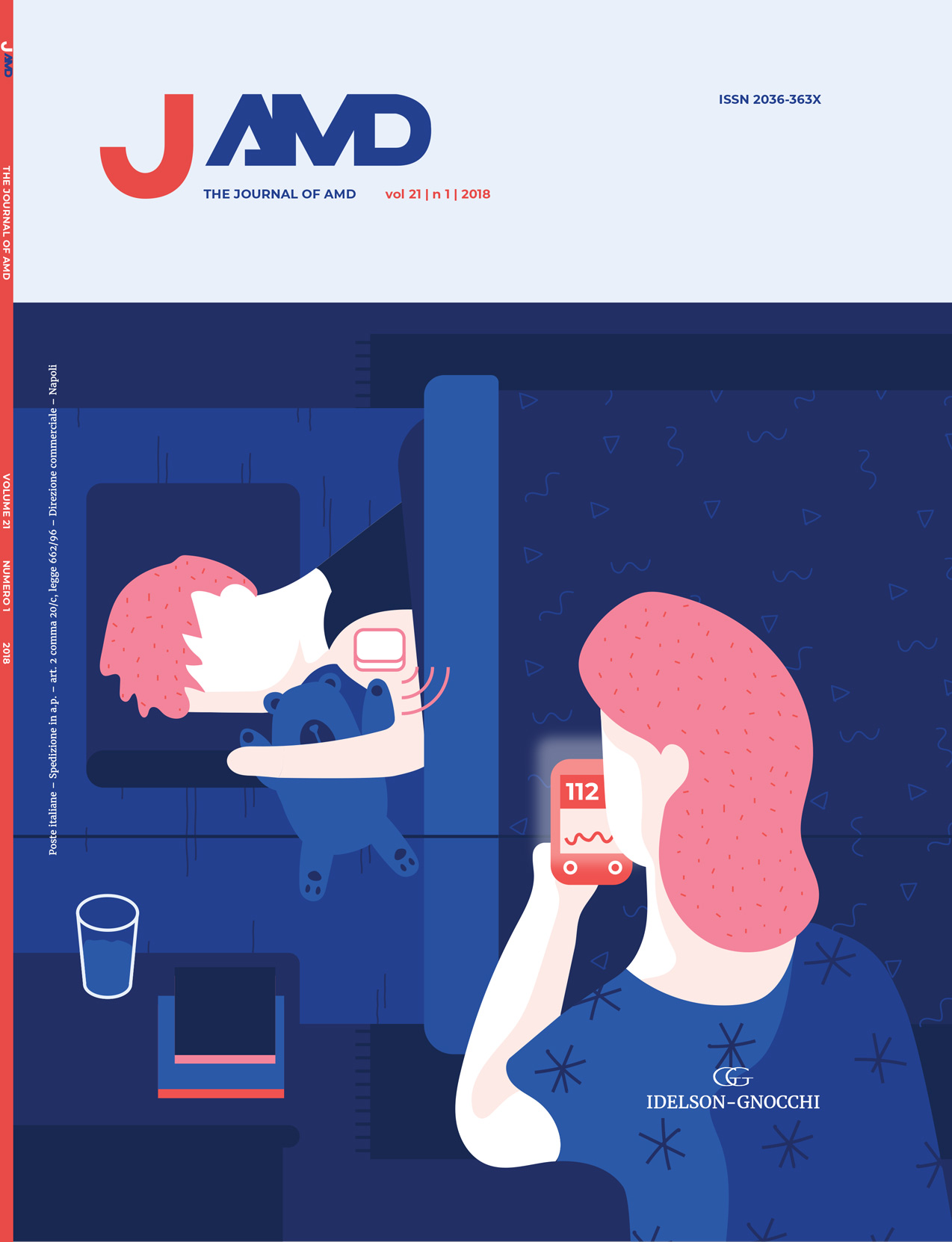Editorial
Toward an “happy degrowth”?
JAMD 2018;21(1):4-
Original articles
More and more elderly diabetics: toward evidence-based deprescribing?
JAMD 2018;21(1):5-13
Overtreatment is pervasive in elderly persons, especially in diabetic patients, but drugs often have side effects and negative interactions and evidence about strict glycemic control is lacking. Many opinion leaders recommend deprescribing, but this is seldom implemented, as awareness of the problem and adequate information about risks and benefits often lack in doctors and patients. There is enough evidence to conduct this process in a judicious manner. The glycemic goal for the elderly may be HbA1c between 7.5 and 9%, in relation to age, duration of diabetes, cognitive impairment, concomitant diseases, the type and number of antidiabetic drugs, family and social support. Critical components of deprescribing are a careful analysis of all drugs and their therapeutic significance and side effects and teaching and sharing treatment options on the basis of the patient’s values and quality of life.
KEYWORDS Clinical decision making, Diabetes mellitus, Diabetes complications, Evidence based medicine, Medical overuse.
Prescription of drugs in multimorbidity: when is it too much?
JAMD 2018;21(1):14-20
The patient with multimorbidity is often in therapy with many drugs and he is exposed to an increased risk of adverse drug reactions (ADR), which are associated with the risk of important negative outcomes such: access to the emergency room, hospitalizations, morbidity and mortality. In fact, polytherapy is the first risk factor for ADR in the elderly population. About 80% of ADRs are potentially predictable and therefore avoidable. The main predictors of prescriptive inappropriateness are age, co-morbidities and polytherapy, and therefore the elderly patient is at high risk of inappropriate prescriptions. Several criteria are described in the literature to identify and evaluate the prescribing inappropriateness in the elderly population; the most used internationally are the Beers Criteria and the STOPP and START Criteria. The numerous data concerning the negative effects of polytherapy indirectly support the need to reduce the number of prescriptions in the patient with multimorbidity. Some authors propose a guide to deprescription and in this context the application of the aforementioned criteria is a fundamental component. Recently, algorithms have been published to facilitate the process of deprescription and some early indications for drugs and specific situations are available: this may be the beginning of a path that will lead the Guidelines to include in their indications also the principles of deprescription.
In conclusion, it is important that we develop a pro-active attitude to the deprescription and use of appropriate drugs, with the aim of reducing the clinical risk for our patients.
KEYWORDS Chronic disease, Multimorbidity, Primary health care, General practitioner, Deprescribing.
Risk factors for low therapeutic adherence in outpatients with type 2 diabetes: a single center experience
JAMD 2018;21(1):21-26
Adherence with hypoglycaemic agents is crucial to achieve optimal glycaemic control. We aimed to evaluate the adherence levels and identify risk factor associated to low therapeutic adherence among outpatients with Type 2 Diabetes. We collected socio-demografic and clinical data in 150 consecutive outpatients from our database. Inclusion criteria were:diagnosis of type 2 diabetes, independence in activity daily living, not insulin therapy, absence of depression or cognitive impairment, not recent variation of antidiabetic treatment. Medication adherence was measured using the 8-item Morisky Medication Adherence Scale (MMAS-8), with a score <8 classified as low adherence. Data for self blood glucose monitoring frequency were obtained from the analysis of glycaemic samples from personal blood glucose meters during a period of 90 days. We used a multivariate logistic regression model to identify riskfactors associated with low adherence. Of 150 patients, 53,3% were male. Mean age were 65,3+14,2year. In our study sample only 76 patients (50,7%) were high adherers, and 127 (70%) were no adherers. Compared to high adherers, no adherers had higher HbA1c levels (p = 0.0046) but no differences in complication rates. In multivariate logistic regression model,male gender (p 0.0136), active working status (p 0.038), loneliness (p 0,051), taking 5 or more medication daily (p 0,006) were statistically significant factors associated with non-adherence. Adherence to a structured self blood glucose monitoring appeared to be associated to higher therapeutic adherence (p = 0,0001). In our study sample low medication adherence is a significant problem among patients with type 2 diabetes. Male gender, working status, loneliness, taking 5 or more medication daily were strong correlates of low adherence. Our data underscores the need for management programs to identify and take appropriate actions in order to improve medication adherence in this vulnerable population.
KEYWORDS Therapeutic adherence, Type 2 diabetes, Polypharmacy risk factors.
Punto di vista
Reflections on adherence
JAMD 2018;21(1):27-29
Esperienze in diabetologia clinica
Proposed procedure for education in patient using Flash Glucose Monitoring
JAMD 2018;21(1):30-35
INTRODUCTION In accordance with the Region Tuscany deliberation n° 829 on 30/08/2016 Glucose Flash Monitoring System (FGM) can be prescribed to all patients affected by type 1 Diabetes (T1DM), to women affected by pregestational diabetes or planning a pregnancy, and to specific groups of patients affected by type 2 Diabetes on multiinjective insulin therapy(T2DM). Therefore, we predict a significant gain of patients number who would ask for this continuous glucose monitoring system innovative technology.
AIMS Our aim is to plan the outpatients access for both prescription and education to the correct use of FGM, creating a traceable path, by identifying dedicated areas and specific staff.
MATERIAL AND METHODS At our Diabetologic Unit in Legorn we elaborated a new ambulatory procedure, specific for the education of our patients who need FGM use; this procedure has been shared by the healthcare workers involved, and it consists of two check-lists that are made of all the educational appropriated steps. The educational process needs two sessions, that are realized during the medical visit for type 1 Diabetes as a test period of two weeks. When the test period has finished, outpatients come to download data on PC and to discuss results with the diabetologist, to decide about prescription.
RESULTS This new procedure allows firstly to ensure a complete and standardised education by progressive steps, and then to optimize our medical prescripions, improving the use of a new technology provided by Tuscany Region for insulin-treated patients. However, we need to implement this kind of procedure, especially concerning advanced functions use of this system and the lack of shared clinical guidelines for therapeutical decisions about insulin treatment.
CONCLUSIONS Our experience has confirmed therapeutical education’s role for the good use of new technologies available into the field of diabetes. Recommendations from main scientific societies are necessaries, involving algorithms for the best insulin therapy management of the patient based on the data from FGM.
KEYWORDS Diabetes, Flash Glucose Monitoring, Therapeutic education, Tuscany Region.
Unfair city. Social determinants of health and city
JAMD 2018;21(1):38-45
The elements that determine social and economic position, such as education, employment, income, ethnicity, gender, are the most powerful determinants of population health in modern societies. Development, industrialization, globalization and urbanization affect the destiny of health based on the social position one has and the context in which one lives and the unequal distribution of money, power and resources is the ultimate and structural cause of the current, increasing, inequalities in health, with a social gradient of health present in all the countries of the world and which concerns all human beings, linked not only to poverty or wealth but to inequalities of the possibility of being, of doing, and of having control over one’s own life. Cities are a lens that magnifies or decreases other social determinants of health. The rapid, unplanned and ubiquitous urbanization creates social stratification and becomes itself a structural determinant of health on a triple front: communicable diseases, non-communicable diseases (the new urban epidemic) and physical injuries. Cities offer both the best environment and the worst for health and well-being: multiple determinants converge and positive and negative influences tend to cluster according to the specific neighborhood or “place” within the city, with an unequal distribution of possibilities and consensual inequality in the distribution of health and life expectancy. In the megalopolises of the southern hemisphere as well as in the cities of the most developed countries – where half of humanity lives – what most compromises health is exclusion, not only distance from infrastructures and services, from the attributes of urban life privilege of the minority: political voice, adequate houses, security and guarantees of law, adequate transport, healthy food, work and decent income, access to goods and services and credits, in short all that determines full citizenship. But being the places made by human beings, the settings can also be modified, improved and transformed and the cities can become an opportunity to achieve equity in health and to give meaning to the words solidarity, social cohesion and justice.
KEYWORDS Social determinants, Health determinants, Urbanization, Inequality, Equity
Slow smart city, let’s get back to our cities starting from food
JAMD 2018;21(1):46-48
Modernity has ousted the rural, the natural from our lives. The model of industrial production has in fact absorbed every aspect of our life, leading to an urbanization that places the primary sector outside the city limits. A process that begins with the development of the first cities, dominated throughout the pre-industrial era by crop cycles: not only was food grown and raised within the city space, but streets and public areas were the only places where food was sold and bought. Everything changes with the industrialization and the arrival of the railway when the city can grow in every form and direction, with no more geographical constraints limiting growth and access. With cars we reach total emancipation of the city from any visible relationship with nature. And at the birth of food that made us dependent on unsustainable and harmful models, for both us and the planet. What can you do? How to reverse the route then? Let’s find out the answer in a model of city that reconquers rural space.
KEYWORDS Rural identity, Urbanization, Urban agriculture, Sociality.
The “diabetogenic” city
JAMD 2018;21(1):49-56
When we talk about prevention of diabetes mellitus, we think of an adequate lifestyle for nutrition and regular physical activity, aspects which in fact imply a choice and commitment of the individual. The scientific literature – with rhythms certainly different from those that characterize the pharmacological novelties – offers us data that show a “diabetogenic” role of light pollution, road traffic noise, abnormal sleep rhythm, social discomfort. All these elements are increasingly present – in a structural way – in our cities.
When planning strategies to prevent diabetes it will be appropriate to take these aspects into account.
KEYWORDS Artificial light-at-night, Road traffic noise, Chemical exposures, Heavy metals, Social capital.
Smart, health city, public space and diabetes
JAMD 2018;21(1):57-62
The prevention and management in time of Chronic Non-Communicable Diseases (NCD) cannot be separated from the quality of the living space and not secondarily of the outdoor space, especially in urban contexts.
Extensive research in different disciplines can be translated into actions that will improve health, on the condition of adopting a holistic and transdisciplinary approach oriented to the health and quality of the city: from biology to medicine and social-health assistance, transport planning, urban planning, landscape architecture, environmental protection, space design and multimedia communication.
The shared knowledge is fundamental, in the perspective of operational models for the cities. According to this address, the article highlights the well-established health and city specifications, with a view to physical mental and social wellbeing, with particular attention to urban health objectives for NCD and diabetes, and to initiatives which are expected at European and Italian level.
The central theme is the city as a place of prevention through the improvement of walkability and the possibility of physical exercise for different levels of skills, related to chronic illness, identifying the tools and processes to increase the active use of urban outdoor space. Ensuring comfort, safety, accessibility – physical and social – and usability – based on physical and mental health conditions – of outdoor spaces requires to redefine the design criteria and the technologies for equipment, improve management, supporting both administrations that the capacity for social inclusion and innovation of communities, from the forms of public-private partnerships to the agreements for urban common goods.
KEYWORDS Health city, Outdoor open public space, Physical activity, Spaces and furniture design.
From Urban Health to Urban Diabetes
JAMD 2018;21(1):63-71
The urban population of the world has grown rapidly; every year it increases of about 60 million, mainly in middle-income countries. One hundred years ago, only 2 in 10 people in the world were living in urban areas. By 2050, 7 out of every 10 people will be city dwellers. According to population growth projections, the global growth over the next 30 years will be in urban areas. The migration to urban areas is combine with important changes in lifestyles: jobs are more sedentary, requiring less physical activity, a primary cause of obesity and diabetes. Urbanization, associated with changing dietary patterns, less physical activity and the progressively ageing population increase the risk of developing diabetes, one of the most common chronic diseases in the world. Two thirds of people with diabetes live in big cities. According to IDF, 246 million (65%) of people in the world living in urban have type 2 diabetes, compared to 136 million of rural areas. This gap is destined to grow. In 2040 it is estimated that approximately 75% of people with diabetes will be living in urban areas: 347 million compared to 147 million living out from them. Also in Italy, The Urban Diabetes is an emerging issue of public health: 36% of the population lives in 14 metropolitan cities and about 1.2 million of people have diabetes.
Cities Changing Diabetes© was born in 2014 in Denmark to put in place an overall strategy aimed to build the cities as “promoters of health”. The aim is to create a unitary movement to stimulate national and international policy makers to consider the issue of Urban Diabetes as a priority.
Cities Changing Diabetes® focus on mapping social and cultural factors by crossing data, in order to develop a global action.
The quantitative survey of Cities Changing Diabetes® in Rome has the objective to study the perception of citizens in different urban areas, in relation to the presence of services. The investigation shows that the health is the most important issue by all respondents, with greater allocation in Rome hinterland, respect to the other provinces of Lazio. According to ISTAT data, in 2015 the prevalence of diabetes in Lazio was 6.6%. Compared to 2000, the prevalence has grown from 5.0% to 6.5% among men, and from 4.2% to 6.8% in women. Lazio has one of the highest prevalence of diabetes, preceded only by Calabria and Campania.
Cities Changing Diabetes® aims to facilitate the sharing of cities experiences, to propose actions that can have a positive effect on health through the adoption and implementation of large-scale solutions to counter the expansion of type 2 diabetes and obesity in metropolitan areas.
KEYWORDS Urbanization, Diabetes, Obesity, Migration, Sedentary lifestyle, Public health, Smart cities, Social conditions, Population aging, Demographic changes, Social isolation, Chronicity, Health promotion.




